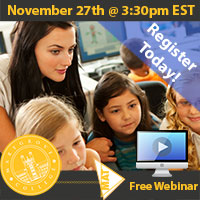 The holiday season is here, but many of our students have already been dining on Thanksgiving turkey, unwrapping holiday gifts and ringing in the New Year for the last week—at least mentally! We’re all getting a little stir crazy, but save your voice for making toasts and catching up with family. When your students get rowdy, don’t yell, let music do the talking for you! Here are a few simple steps you can take to use music as a classroom management tool.
The holiday season is here, but many of our students have already been dining on Thanksgiving turkey, unwrapping holiday gifts and ringing in the New Year for the last week—at least mentally! We’re all getting a little stir crazy, but save your voice for making toasts and catching up with family. When your students get rowdy, don’t yell, let music do the talking for you! Here are a few simple steps you can take to use music as a classroom management tool.
Let music do the talking: Using music as a classroom management tool
What’s the system? How does it work?
The classroom is, generally speaking, a voice-dominated environment—which is why music is such a powerful tool for cutting through student chatter and sending out a resounding message.
The idea is to use specific songs (not your voice) to cue behaviors and classroom activities.
We gleaned the idea from Ian Byrd, a teacher who blogs about differentiated instruction for high-level learners. When he wants chattering students to return to their seats, for example, he doesn’t say anything; instead, he simply walks over to his computer, plays the Andy Griffith theme song and watches his students wrap up and relocate to their desks.
What you need
All you’ll need is a computer (or an mp3 player), a pair of speakers and a music-streaming service like iTunes or Spotify.
The upside to using iTunes is that you don’t need an Internet connection to play songs and create a playlist. You will, however, have to pay for music.
If you go with Spotify, you can create your own playlist and stream any song you want for free, but you’ll need an Internet connection to do so—and you’ll have to tolerate the occasional commercial interruption.
What makes music a fun classroom management tool is that your students will eventually start to sing (or whistle) along—and you probably will too!
If you purchase a cheap USB microphone and download Audacity or Garageband, you can even record your own theme songs like Byrd has done. Or better yet, why not have your students record their own theme songs?
Things to keep in mind when using this system:
- Be consistent (so that you don’t confuse your students—or yourself—rename songs with the behavior you want each song to correspond to
- Don’t overplay music. You don’t want the novelty of it to wear off
- Use music as a timer. For example, if students take too long to line up for something, play a short, 30-second theme song and make lining up a competition to see if they can do so before the song finishes playing
- Let them sing along, dance and wiggle along to the music!
Replies to This Discussion
-
Thank you for reminding me of the power of music! I occasionally play "background" music to calm the students down or as "white noise" while they work. I have never thought about using music as cues before though! I can't wait to try it!
-
Hi, Staci:
Thank you so much for taking the time to read and comment. Please keep me posted on how this works in your classroom!
© 2025 Created by Steve Hargadon.
Powered by
![]()
